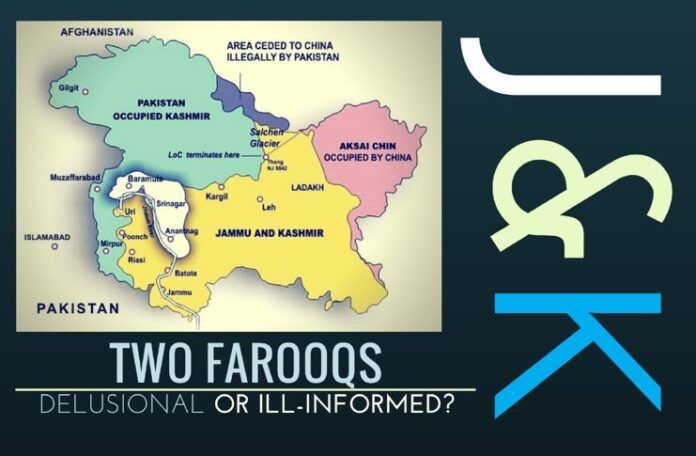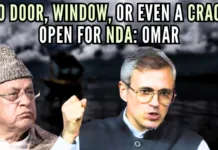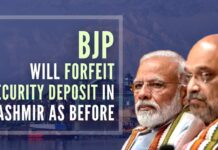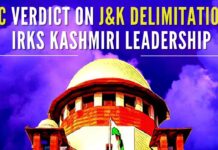
Summary
Farooq Abdullah appears to have forgotten some critical sections in J & K Constitution.
Farooq and National Conference have suddenly changed course and are aligning with the separatists
In a sixteen year period, J & K gets 10% allocation despite having just 1% of the country’s population.
[dropcap color=”#008040″ boxed=”yes” boxed_radius=”8px” class=”” id=””]I[/dropcap]n my previous article (Farooq Abdullah doesn’t have a Lakshman Rekha…), Farooq Abdullah, President of the National Conference party of Jammu & Kashmir, had been reminded of Section 4 of the J&K State Constitution whereby the territory called Azad Kashmir by Pakistan and Pak-Occupied Kashmir was proved to be very much a part of India’s Jammu & Kashmir State.
Today, I’m constrained to remind the man who was Chief Minister of J&K for 20 years of another hard Constitutional fact. At 80 years of age, some memory loss is forgivable. But he just cannot get away burying Section 3 of his State’s Constitution which says that “The State of Jammu and Kashmir is and shall be an integral part of the Union of India.” Further, under Section 147 of that very Constitution, “no bill or amendment seeking to make any change in the provisions of Section 3… shall be introduced or moved in either House of the Legislature.” Clearly, that destiny of J&K State with the Union of India is etched in the rock hard stone of eternity.
Hence, there was no plausible reason why Farooq Abdullah, at Srinagar on December 5, 2016, publicly told the “separatist” Hurriyat leaders that “We are with you at this moment… the path to Azadi is never easy”.
[dropcap color=”#008040″ boxed=”yes” boxed_radius=”8px” class=”” id=””]T[/dropcap]his, with some other startling comments of his was reported in the reputed newspaper, “The Tribune”, at http://www.tribuneindia.com/news/jammu-kashmir/farooq-talks-azadi-ready-to-unite-with-separatists/332763.html. It’s also disturbing to note that son Omar Abdullah was present when the father spoke.
For those who are not aware, the ideology of the Hurriyat Conference (a conglomerate of 30 political parties) is that “Jammu and Kashmir is a disputed territory and India’s control of it is not justified. It supports the Pakistani claim that Kashmir is the “unfinished agenda of Partition” and needs to be solved “as per the aspirations of the people of Jammu and Kashmir.” And remember that the Hurriyat includes the JK Liberation Front of ex-terrorist Yasin Malik with which Farooq “Sa’ab” is alleged to have been linked to. in his relatively younger age spent in London studying and practising his medical profession,
The unstated “logic” behind the Hurriyat argument is that just as India itself was partitioned into India (Hindustan) and Pakistan on the basis of religion of the majority of the population, J&K State should also be similarly divided and because it has a pronounced Muslim predominance, it should be included in Pakistan.
A known ideologue of the above objective is Mirwaiz (Mir=Head; Waiz=Priest) Umar Farooq, chairman of the Awami Action Committee, a member of the Hurriyat, who has both an important religious and political role in the Kashmir Valley, and Farooq is seen as the spiritual leader of Kashmir’s Muslims. The foundation for his suggestion for resolving the so-called Kashmir issue is “the fact that right to self-determination for the people of J&K is non-negotiable.” (Free Press Joanna, Mumbai, 26th Oct. 2016). Clearly, the man is advocating a Plebiscite which he’s sure will lead to the J&K people voting for either an independent Kashmir State or for merging with Pakistan.
Although only 43 years old, the Mirwaiz carries himself with air of an erudite, self-confident about his political prognosis. No media has known to cross examine him on it. But time has come to apprise him of certain relevant historical facts. So, here it goes.
-
His Majesty’s Government’s announcement of Jun 3, 1947 made it clear that its provision for the creation of two independent dominions was only for the provinces comprising British India. It provided that the Muslim majority areas in British India should constitute the Dominion of Pakistan and the Hindu majority areas should constitute the Dominion of India. A small paragraph in that announcement made it clear that the communal basis of the division of India would not affect the Princely Sates at all and that they all would be made “legally independent” so that the sovereignty of these States would revert to the Ruler. The power to accede to either Dominion was given to him and he was to sign the Instrument of Accession in exercise of his “sovereignty in and over his State.” (pg. 66, Justice A.S. Anand in his book “The Constitution of Jammu & Kashmir”, Universal Law Publishing Co. Pvt .Ltd., Third Edition, 1998.)
-
In his address to the Chamber of Princes on July 25, 1947, Lord Mountbatten, British India’s Governor General and Crown Representative advised the Princes that although legally they had become independent, they should decide to accede to one or the other Dominions keeping in mind the “geographical congruity” of their States. Accession, he told them, was to be under the Cabinet Mission Memorandum of May 16, which contemplated surrender to the Central Government of only three subjects, Defence, External Affairs and Communications. After warning the States “if you do not link with one or the other Dominions, you may be ct off from any source of supply.” He thereafter caused a draft Instrument of Accession which provided for surrender to the appropriate Dominion the power over the afore-mentioned three subjects, without any financial liability. Clearly, Lord Mountbatten had ruled out the “Independence” option to the Princely States. (pg.67, ibid).
-
In June 1949, the Yuvraj of J&K, on the advice of his Council of Ministers, nominated four representatives to the Indian Constituent Assembly, Unlike those from other States, the J&K State’s representatives made it clear that Kashmir’s association with India would be based “only” on the terms of the Instrument of Accession (IOA).IOA, More importantly, under clause (7) of the IOA, the J&K State did not commit itself to the acceptance of any future Constitution of India. Clearly, the people of J&K, led by its legendary Lion of Kashmir, Sheikh Abdullah (father of Farooq) was harbouring a new Constitution for the State to replace its earlier one of 1939 created by the State’s Maharaja.
-
There were two ironies in this regard. First, although the State’s four representatives were in the Indian Constituent Assembly to enact a new Constitution for free India, the ultimate Constitution of India (which came into force on January 26, 1950) was allowed to include J&K as a part of the Territory of India in Article 1 itself. Secondly, although the State representatives were initially obstinate about strictly restricting the Central Government’s legislative control to the three subjects in the IOA, the Indian Constitution was allowed to include (albeit as a temporary provision) the controversial Article 370 which, under Sub-section (1) (d),, permits the provisions of the Constitution of India to be applicable to J&K State, albeit with the consent of the J&K Sate government. That, incidentally, is the beneficial effect of Article 370, though its removal altogether would be the ideal to achieve from the national interest perspective.
-
On May 1, 1950, Yuvraj Karan Singh issued a proclamation calling for an election, on the principle of universal adult franchise, to constitute a Constituent Assembly for framing a Constitution for the J&K State. The elections to that Assembly were were completed by August that year. And the first meeting of that Constituent Assembly was held on October 31, 1951. He called that day as the “date of destiny… A date which comes only once in the life of a nation.” He then listed the main objects and functions of that “Sovereign Assembly.” One of the items in that list was “to declare its reasoned conclusions regarding accession of the State. He enumerated three alternatives: accession to India, accession to Pakistan or complete independence.” (pgs. 118 and 119, ibid). And what emerged was the J&K State Constituted enacted on 17th November 1956.
[dropcap color=”#008040″ boxed=”yes” boxed_radius=”8px” class=”” id=””]T[/dropcap]he most significant stone it made is in its Section 3 cited at the beginning of this article. And what was most conspicuous about that Section is that it is not amenable even to a Constitutional amendment. “This was done to avoid fissiparous tendencies raising their ugly head in the future.” (pg.202, ibid)
Are you listening, Umar and Farooq? Can you tell us a better exercise of the right to self-determination? If you can, go and complain to Unrepresented Nations and Peoples Organization (UNPO) which defines Self-Determination as “Essentially, the right to self-determination is the right of a people to determine its own destiny. In particular, the principle allows a people to choose its own political status and to determine its own form of economic, cultural and social development.” (http://www.unpo.org/article/4957)
Meanwhile, the two Farooqs must also be reminded that Switzerland does not flourish only because of its tourism. It also has a world reputation in manufacturing, chocolates, cheese, pharmaceuticals and watches.
And, perhaps more importantly, the two as well as the rest of India must be informed that, according to an analysis by “The Hindu” of Central and State finances, Jammu and Kashmir State received Rs.1.14 lakh crore in grants over the sixteen years, 2000-2016, according to the Union Finance Ministry’s data. This is more than a quarter of the Central funds disbursed to the 11 special category States in that period. This bounty to J&K came to 10 per cent of all Central grants given to States over the review period, despite that State having only one per cent of the country’s population. (http://www.thehindu.com/news/national/other-states/JampK-gets-10-of-Central-funds-with-only-1-of-population/article14506264.ece
- To Editors’ Guild; May we also have our say… please? - July 17, 2019
- Farooq Sahab is either down with dementia or he is a congenital liar? - July 8, 2019
- Shah Bano, Muslims in gutter &Zakaria’s secularism - June 30, 2019











J&K is integral part of India included parts occupied by China and Pakistan and one day all areas will be recovered by India by war or peace.
China cant occupy our land and Pakistan also cant hold our land in occupation.
Now J&K be divided into 3 states Kashmir,Jammu and Ladakh.It will solve the problem of hurriyats demand.Jammu is majority in J&K.But inspite of Hindu Majority Kashmir getting all benefits and Jammu remaine dunde developed.The pundits driven out from thei homes in Kashmir must be resettled in Jammu region as they cant go to Kashmir where Muslim majority made their life by hostile behavior.Jammu be made capital of Kashmir and Shrinagar be made a tourist town.Jammu be developed.The delimitation commission be endowed with powers to demarcate new constituencies for assembly and Lokasbha.J&K shud be made a part of India by removal of its constitution and article 370.Kashmir valley be handed over to ARMY.